Warming ocean water is turning 99 percent of these sea turtles female
Rising temperatures are skewing population ratios toward extreme imbalance

TURTLE TROUBLE Green sea turtle populations in parts of the Great Barrier Reef are becoming increasingly female because their eggs are being incubated at higher temperatures due to warming ocean waters.
Howcheng/Wikimedia Commons (CC0 1.0)







